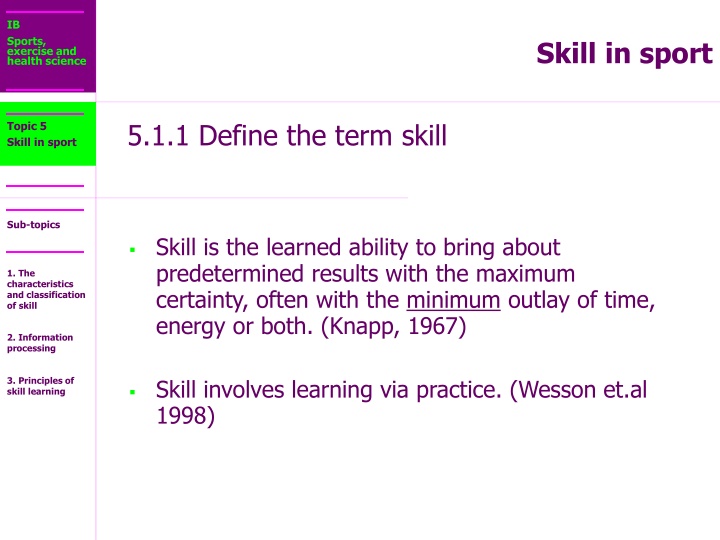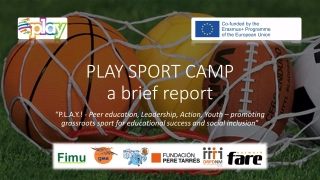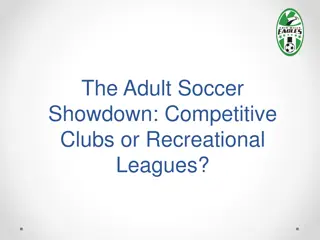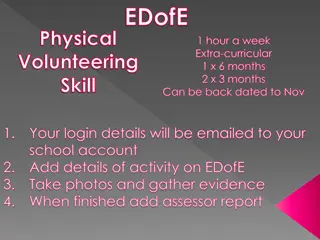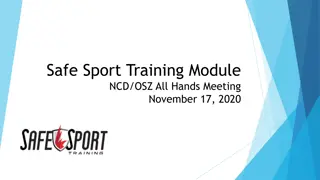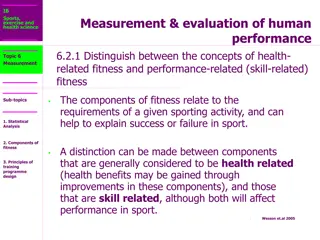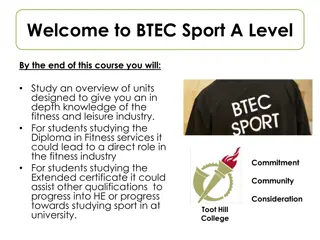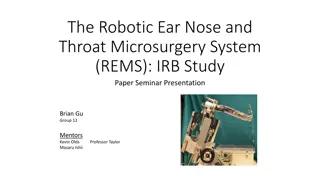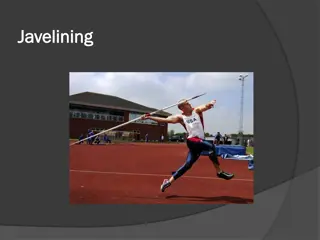Skill in sport
Skill in sport is the learned ability to achieve predetermined results efficiently. It involves cognitive, perceptive, and motor skills, which are often intertwined in sports performance. Different types of skills, such as cognitive, perceptive, and motor skills, contribute to an athlete's proficiency in various sports. This understanding of skill is vital in sports science for enhancing athletic performance through effective skill acquisition and mastery.
Download Presentation

Please find below an Image/Link to download the presentation.
The content on the website is provided AS IS for your information and personal use only. It may not be sold, licensed, or shared on other websites without obtaining consent from the author.If you encounter any issues during the download, it is possible that the publisher has removed the file from their server.
You are allowed to download the files provided on this website for personal or commercial use, subject to the condition that they are used lawfully. All files are the property of their respective owners.
The content on the website is provided AS IS for your information and personal use only. It may not be sold, licensed, or shared on other websites without obtaining consent from the author.
E N D
Presentation Transcript
IB Sports, exercise and health science Skill in sport Topic 5 Skill in sport 5.1.1 Define the term skill Topic 5 Skill in sport Sub-topics Skill is the learned ability to bring about predetermined results with the maximum certainty, often with the minimum outlay of time, energy or both. (Knapp, 1967) Skill involves learning via practice. (Wesson et.al 1998) Skill is the learned ability to bring about predetermined results with the maximum certainty, often with the minimum outlay of time, energy or both. (Knapp, 1967) 1. The characteristics and classification of skill 1. The characteristics and classification of skill 2. Information processing 3. Principles of skill learning 2. Information processing Skill involves learning via practice. (Wesson et.al 1998) 3. Principles of skill learning
IB Sports, exercise and health science Skill in sport Topic 5 Skill in sport 5.1.1 Define the term skill Topic 5 Skill in sport Sub-topics Thus a skilful performer has gone through some form of learning process . They are consistent . The performance is also carried out efficiently i.e. not wasting time or energy. Wesson et.al (1998) Thus a skilful performer has gone through some form of learning process . They are consistent . The performance is also carried out efficiently i.e. not wasting time or energy. 1. The characteristics and classification of skill 1. The characteristics and classification of skill 2. Information processing 3. Principles of skill learning 2. Information processing 3. Principles of skill learning Wesson et.al (1998)
IB Sports, exercise and health science Skill in sport Topic 5 Skill in sport 5.1.2 Describe the different types of skill Topic 5 Skill in sport Examples of three different types of skill are: Cognitive skills or intellectual skills involve the use of a person s mental powers, e.g. problem solving, verbal reasoning, good decision making (creating a play in football). Perceptive skills: Interpreting and making sense of information coming in via the senses (reading the green on golf course, rock climbing, reading a play in football). Motor skills: Smoothly executing physical movements and responses. Using your muscles well (weightlifting, sprinting). Wesson et.al (1998) Examples of three different types of skill are: Cognitive skills or intellectual skills involve the use of a person s mental powers, e.g. problem solving, verbal reasoning, good decision making (creating a play in football). Perceptive skills: Interpreting and making sense of information coming in via the senses (reading the green on golf course, rock climbing, reading a play in football). Motor skills: Smoothly executing physical movements and responses. Using your muscles well (weightlifting, sprinting). Sub-topics 1. The characteristics and classification of skill 1. The characteristics and classification of skill 1. 2. Information processing 3. Principles of skill learning 2. Information processing 2. 3. Principles of skill learning 3.
IB Sports, exercise and health science Skill in sport Topic 5 Skill in sport 5.1.2 Describe the different types of skill Topic 5 Skill in sport Although many psychologists have tried to define the ways in which motor, cognitive and perceptual skills are independent of one another, from a sports science perspective when we talk of skill it is usually a combination of all three areas. Wesson et.al (1998) Although many psychologists have tried to define the ways in which motor, cognitive and perceptual skills are independent of one another, from a sports science perspective when we talk of skill it is usually a Sub-topics 1. The characteristics and classification of skill 1. The characteristics and classification of skill 2. Information processing 3. Principles of skill learning combination of all three areas. 2. Information processing 3. Principles of skill learning Wesson et.al (1998)
IB Sports, exercise and health science Skill in sport Topic 5 Skill in sport 5.1.2 Describe the different types of skill Topic 5 Skill in sport Perceptual motor skills are sometimes referred to simply as motor skills. In this instance the perceptual or cognitive involvement is usually implied. Wesson et.al (1998) Sub-topics Perceptual motor skills are sometimes referred to simply as motor skills. 1. The characteristics and classification of skill 1. The characteristics and classification of skill 2. Information processing 3. Principles of skill learning 2. Information processing In this instance the perceptual or cognitive involvement is usually implied. 3. Principles of skill learning Wesson et.al (1998)
IB Sports, exercise and health science Skill in sport Topic 5 Skill in sport 5.1.3 Outline the different approaches to classifying skill. Topic 5 Skill in sport Skills can be classified to help determine how specific skills can be learned . Classification is based on: The amount of physical effort required (fine/gross) The environment in which the skill is to be performed. The type of movement required The pace of the movement (internal/external) Amount of interaction (individual, coactive, interactive) Smyth et.al (1999) Skills can be classified to help determine how specific skills can be learned . Classification is based on: The amount of physical effort required (fine/gross) The environment in which the skill is to be performed. The type of movement required The pace of the movement (internal/external) Amount of interaction (individual, coactive, interactive) Sub-topics 1. The characteristics and classification of skill 1. The characteristics and classification of skill 1) 2. Information processing 3. Principles of skill learning 2. Information processing 2) 3. Principles of skill learning 3) 4) 5) Smyth et.al (1999)
IB Sports, exercise and health science Skill in sport Topic 5 Skill in sport 5.1.3 Outline the different approaches to classifying skill. Topic 5 Skill in sport 1) Fine/Gross Fine motor skills involve the use of small muscle groups. The performer must balance the use of force and fine touch control. e.g. writing, typing, archery, putting in golf. Smyth et.al (1999) 1) Fine/Gross Sub-topics 1. The characteristics and classification of skill 1. The characteristics and classification of skill Fine motor skills involve the use of small muscle groups. The performer must balance the use of force and fine touch control. e.g. writing, typing, archery, putting in golf. 2. Information processing 3. Principles of skill learning 2. Information processing 3. Principles of skill learning Smyth et.al (1999)
IB Sports, exercise and health science Skill in sport Topic 5 Skill in sport 5.1.3 Outline the different approaches to classifying skill. Topic 5 Skill in sport 1) Fine/Gross Gross motor skills involve a combination of large muscle actions that results in a coordinated movement. e.g. throwing, catching, hitting, kicking, catching and tumbling in gymnastics. Smyth et.al (1999) Sub-topics 1) Fine/Gross 1. The characteristics and classification of skill 1. The characteristics and classification of skill Gross motor skills involve a combination of large muscle actions that results in a coordinated movement. e.g. throwing, catching, hitting, kicking, catching and tumbling in gymnastics. 2. Information processing 3. Principles of skill learning 2. Information processing 3. Principles of skill learning Smyth et.al (1999)
IB Sports, exercise and health science Skill in sport Topic 5 Skill in sport 5.1.3 Outline the different approaches to classifying skill. Topic 5 Skill in sport 2) Environment Open Motor Skills: are performed in an environment that is constantly changing and is externally paced. For example, the changing proximity of an opponent, the changing speed and height of a wave in surfing or the varying speed of a ball in cricket. Smyth et.al (1999) 2) Environment Sub-topics 1. The characteristics and classification of skill 1. The characteristics and classification of skill Open Motor Skills: are performed in an environment that is constantly changing and is externally paced. For example, the changing proximity of an opponent, the changing speed and height of a wave in surfing or the varying speed of a ball in cricket. 2. Information processing 3. Principles of skill learning 2. Information processing 3. Principles of skill learning Smyth et.al (1999)
IB Sports, exercise and health science Skill in sport Topic 5 Skill in sport 5.1.3 Outline the different approaches to classifying skill. Topic 5 Skill in sport 2) Environment Closed Motor Skills: are performed in a predictable environment where there are no interruptions or changes in the surroundings. The athlete often tries to replicate the exact movement each time in a closed skill, internally paced For example ten pin bowling., for example, a golfer with his or her swing when teeing off. Smyth et.al (1999) 2) Environment Sub-topics 1. The characteristics and classification of skill 1. The characteristics and classification of skill Closed Motor Skills: are performed in a predictable environment where there are no interruptions or changes in the surroundings. The athlete often tries to replicate the exact movement each time in a closed skill, internally paced For example ten pin bowling., for example, a golfer with his or her swing when teeing off. 2. Information processing 3. Principles of skill learning 2. Information processing 3. Principles of skill learning Smyth et.al (1999)
IB Sports, exercise and health science Skill in sport Topic 5 Skill in sport 3) Type of Movement Discrete/Continuous/Serial Skills: Discrete Skills: involve movements of brief duration, and are defined by a distinct beginning and end. For example a throw, kick or catch. Smyth et.al (1999) 5.1.3 Outline the different approaches to classifying skill. Topic 5 Skill in sport 3) Type of Movement Sub-topics 1. The characteristics and classification of skill 1. The characteristics and classification of skill Discrete/Continuous/Serial Skills: Discrete Skills: involve movements of brief duration, and are defined by a distinct beginning and end. 2. Information processing 3. Principles of skill learning 2. Information processing 3. Principles of skill learning For example a throw, kick or catch. Smyth et.al (1999)
IB Sports, exercise and health science Skill in sport Topic 5 Skill in sport 3) Type of Movement Discrete/Continuous/Serial Skills: Continuous skills: have no distinct beginning and end point. May continue for several minutes, often involving tracking movements For example swimming, running, biking. Smyth et.al (1999) 5.1.3 Outline the different approaches to classifying skill. Topic 5 Skill in sport 3) Type of Movement Sub-topics 1. The characteristics and classification of skill 1. The characteristics and classification of skill Discrete/Continuous/Serial Skills: Continuous skills: have no distinct beginning and end point. May continue for several minutes, often involving tracking movements 2. Information processing 3. Principles of skill learning 2. Information processing 3. Principles of skill learning For example swimming, running, biking. Smyth et.al (1999)
IB Sports, exercise and health science Skill in sport Topic 5 Skill in sport 3) Type of Movement Discrete/Continuous/Serial Skills: Serial Skills: are a series or group of discrete skills strung together to create a more complicated, skilled action. For example performing a gymnastics routine. Smyth et.al (1999) 5.1.3 Outline the different approaches to classifying skill. Topic 5 Skill in sport 3) Type of Movement Sub-topics 1. The characteristics and classification of skill 1. The characteristics and classification of skill Discrete/Continuous/Serial Skills: Serial Skills: are a series or group of discrete skills strung together to create a more complicated, skilled action. 2. Information processing 3. Principles of skill learning 2. Information processing 3. Principles of skill learning For example performing a gymnastics routine. Smyth et.al (1999)
IB Sports, exercise and health science Skill in sport Topic 5 Skill in sport 4) Pace External Paced: Action is determined by external sources and involves the performer in reaction. Is a more open skill e.g. white water canoeing, receiving a serve in tennis. Internal Paced: Performer controls the rate at which the activity is carried out and decides when to initiate movement. Is a more closed skill e.g. shot put, forward roll. Wesson et.al (1998) 5.1.3 Outline the different approaches to classifying skill. Topic 5 Skill in sport 4) Pace Sub-topics External Paced: Action is determined by external sources and involves the performer in reaction. Is a more open skill e.g. white water canoeing, receiving a serve in tennis. Internal Paced: Performer controls the rate at which the activity is carried out and decides when to initiate movement. Is a more closed skill e.g. shot put, forward roll. 1. The characteristics and classification of skill 1. The characteristics and classification of skill 2. Information processing 3. Principles of skill learning 2. Information processing 3. Principles of skill learning Wesson et.al (1998)
IB Sports, exercise and health science Skill in sport 5) Interaction Continuum: (Individual/Coactive/Interactive) A method of describing groups of skills is to group them according to whether the skill is performed as an Individual skill - without reference to another player Coactive skill - when others are involved but no direct confrontation Interactive skill - dependent upon interaction with others involving direct confrontation http://www.megaessays.com/viewpaper/26561.html Topic 5 Skill in sport 5.1.3 Outline the different approaches to classifying skill. Topic 5 Skill in sport 5) Interaction Continuum: (Individual/Coactive/Interactive) Sub-topics 1. The characteristics and classification of skill 1. The characteristics and classification of skill A method of describing groups of skills is to group them according to whether the skill is performed as an Individual skill - without reference to another player Coactive skill - when others are involved but no direct confrontation Interactive skill - dependent upon interaction with others involving direct confrontation 2. Information processing 3. Principles of skill learning 2. Information processing 3. Principles of skill learning http://www.megaessays.com/viewpaper/26561.html
IB Sports, exercise and health science Skill in sport Topic 5 Skill in sport 5.1.4 Compare skill profiles for contrasting sports. Topic 5 Skill in sport Class Activity: Draw a continuum for each of the five classifications and place a series of relevant examples along the appropriate places along the continuum. Sub-topics Class Activity: Draw a continuum for each of the five classifications and place a series of relevant examples along the appropriate places along the continuum. 1. The characteristics and classification of skill 1. The characteristics and classification of skill 2. Information processing 3. Principles of skill learning 2. Information processing 3. Principles of skill learning
IB Sports, exercise and health science Skill in sport Topic 5 Skill in sport 5.1.5 Define the term ability. Topic 5 Skill in sport Sub-topics Ability is a stable, enduring characteristic, that is genetically determined and may be wholly perceptual, wholly motor or a combination i.e. psychomotor. IBO. Feb 2007 Ability is a stable, enduring characteristic, that is genetically determined and may be wholly perceptual, wholly motor or a combination i.e. psychomotor. 1. The characteristics and classification of skill 1. The characteristics and classification of skill 2. Information processing 3. Principles of skill learning 2. Information processing 3. Principles of skill learning IBO. Feb 2007
IB Sports, exercise and health science Skill in sport Topic 5 Skill in sport 5.1.6 Outline Fleishman s taxonomy of motor abilities. Topic 5 Skill in sport Sub-topics The work of Fleishman (1972), identifies 11 measurable perceptual motor abilities. Wesson et.al (1998) The work of Fleishman (1972), identifies 11 measurable perceptual motor abilities. 1. The characteristics and classification of skill 1. The characteristics and classification of skill 2. Information processing 3. Principles of skill learning 2. Information processing Wesson et.al (1998) 3. Principles of skill learning
IB Sports, exercise and health science Skill in sport Topic 5 Skill in sport 5.1.6 Outline Fleishman s taxonomy of motor abilities. Topic 5 Skill in sport Human Perceptual Motor Abilities: 1.Limb coordination: the ability to coordinate the movement of a number of limbs simultaneously. 2.Control precision: the ability to make highly controlled and precise muscular adjustments 3.Response orientation: the ability to select rapidly where a response should be made 4.Reaction time: the ability to respond rapidly to a stimulus when it appears. Wesson et.al (1998) Human Perceptual Motor Abilities: 1. Limb coordination: the ability to coordinate the movement of a number of limbs simultaneously. 2. Control precision: the ability to make highly controlled and precise muscular adjustments 3. Response orientation: the ability to select rapidly where a response should be made 4. Reaction time: the ability to respond rapidly to a stimulus when it appears. Sub-topics 1. The characteristics and classification of skill 1. The characteristics and classification of skill 2. Information processing 3. Principles of skill learning 2. Information processing 3. Principles of skill learning Wesson et.al (1998)
IB Sports, exercise and health science Skill in sport Topic 5 Skill in sport 5.1.6 Outline Fleishman s taxonomy of motor abilities. Topic 5 Skill in sport Human Perceptual Motor Abilities: 5.Speed of arm movement: the ability to make a gross, rapid arm movement. 6.Rate control: the ability to change speed and direction of response with precise timing, as in following a continuously moving target. 7.Manual dexterity: the ability to make skilful, well-directed arm hand movements, when manipulating objects under speed conditions. 8.Finger dexterity: the ability to perform skilful controlled manipulations of tiny objects involving primarily the fingers. Wesson et.al (1998) Human Perceptual Motor Abilities: 5. Speed of arm movement: the ability to make a gross, rapid arm movement. 6. Rate control: the ability to change speed and direction of response with precise timing, as in following a continuously moving target. 7. Manual dexterity: the ability to make skilful, well- directed arm hand movements, when manipulating objects under speed conditions. 8. Finger dexterity: the ability to perform skilful controlled manipulations of tiny objects involving primarily the fingers. Sub-topics 1. The characteristics and classification of skill 1. The characteristics and classification of skill 2. Information processing 3. Principles of skill learning 2. Information processing 3. Principles of skill learning Wesson et.al (1998)
IB Sports, exercise and health science Skill in sport Topic 5 Skill in sport 5.1.6 Outline Fleishman s taxonomy of motor abilities. Topic 5 Skill in sport Human Perceptual Motor Abilities: 9.Arm hand steadiness: the ability to make precise arm, hand positioning movements where strength and speed are minimally involved. 10.Wrist finger speed: the ability to move the wrist and fingers rapidly, as in a tapping task. 11.Aiming: the ability to aim precisely at a small object in space. Wesson et.al (1998) Human Perceptual Motor Abilities: Sub-topics 1. The characteristics and classification of skill 1. The characteristics and classification of skill 9. Arm hand steadiness: the ability to make precise arm, hand positioning movements where strength and speed are minimally involved. 10. Wrist finger speed: the ability to move the wrist and fingers rapidly, as in a tapping task. 11. Aiming: the ability to aim precisely at a small object in space. 2. Information processing 3. Principles of skill learning 2. Information processing 3. Principles of skill learning Wesson et.al (1998)
IB Sports, exercise and health science Skill in sport Topic 5 Skill in sport 5.1.6 Outline Fleishman s taxonomy of motor abilities. Topic 5 Skill in sport Sub-topics Fleishman identified nine (9) physical proficiency abilities. These differed from perceptual motor abilities in that they are more generally related to gross physical performance. Wesson et.al (1998) Fleishman identified nine (9) physical proficiency abilities. 1. The characteristics and classification of skill 1. The characteristics and classification of skill 2. Information processing 3. Principles of skill learning 2. Information processing These differed from perceptual motor abilities in that they are more generally related to gross physical performance. 3. Principles of skill learning Wesson et.al (1998)
IB Sports, exercise and health science Skill in sport Topic 5 Skill in sport 5.1.6 Outline Fleishman s taxonomy of motor abilities. Topic 5 Skill in sport Typically these more general athletic abilities could be considered physical fitness abilities. Physical Proficiency abilities: 1.Static strength: maximum force exerted against an external object. 2.Dynamic strength: muscular endurance in exerting force repeatedly. E.g. pull ups Wesson et.al (1998) Typically these more general athletic abilities could be considered physical fitness abilities. Sub-topics 1. The characteristics and classification of skill 1. The characteristics and classification of skill 2. Information processing 3. Principles of skill learning Physical Proficiency abilities: 2. Information processing 3. Principles of skill learning 1. Static strength: maximum force exerted against an external object. Dynamic strength: muscular endurance in exerting force repeatedly. E.g. pull ups 2. Wesson et.al (1998)
IB Sports, exercise and health science Skill in sport Topic 5 Skill in sport 5.1.6 Outline Fleishman s taxonomy of motor abilities. Topic 5 Skill in sport Sub-topics 3.Explosive strength: the ability to mobilise energy effectively for bursts of muscular effort, e.g. high jump 4.Trunk strength: strength of the trunk muscles. 5.Extent flexibility: the ability to flex or stretch the trunk and back muscles. 6.Dynamic flexibility: the ability to make repeated, rapid trunk flexing movements as in a series of stand and touch toes stretch and touch toes. Wesson et.al (1998) 3. Explosive strength: the ability to mobilise energy effectively for bursts of muscular effort, e.g. high jump Trunk strength: strength of the trunk muscles. Extent flexibility: the ability to flex or stretch the trunk and back muscles. Dynamic flexibility: the ability to make repeated, rapid trunk flexing movements as in a series of stand and touch toes stretch and touch toes. 1. The characteristics and classification of skill 1. The characteristics and classification of skill 2. Information processing 3. Principles of skill learning 4. 5. 2. Information processing 3. Principles of skill learning 6. Wesson et.al (1998)
IB Sports, exercise and health science Skill in sport Topic 5 Skill in sport 5.1.6 Outline Fleishman s taxonomy of motor abilities. Topic 5 Skill in sport Sub-topics 7.Gross body coordination: the ability to coordinate the action of several parts of the body while the body is in motion. 8.Gross body equilibrium: the ability to maintain balance without visual cues. 9.Stamina: the capacity to sustain maximum effort requiring cardiovascular effort, e.g. a long distance run. Wesson et.al (1998) 7. Gross body coordination: the ability to coordinate the action of several parts of the body while the body is in motion. Gross body equilibrium: the ability to maintain balance without visual cues. Stamina: the capacity to sustain maximum effort requiring cardiovascular effort, e.g. a long distance run. 1. The characteristics and classification of skill 1. The characteristics and classification of skill 2. Information processing 3. Principles of skill learning 8. 2. Information processing 9. 3. Principles of skill learning Wesson et.al (1998)
IB Sports, exercise and health science Skill in sport Topic 5 Skill in sport 5.1.7 Distinguish between physical proficiency abilities and perceptual motor abilities. Topic 5 Skill in sport Written Task: Fleishman (1972) distinguishes between physical proficiency and perceptual motor ability. Write 8 -10 lines clarifying these differences. Sub-topics Written Task: 1. The characteristics and classification of skill 1. The characteristics and classification of skill Fleishman (1972) distinguishes between 2. Information processing 3. Principles of skill learning 2. Information processing physical proficiency and perceptual motor ability. 3. Principles of skill learning Write 8 -10 lines clarifying these differences.
IB Sports, exercise and health science Skill in sport Topic 5 Skill in sport 5.1.8 Define the term technique. Topic 5 Skill in sport Technique = basic movement of any sport. It is the way you move your body (motor control). IBO February 2007 Sub-topics Technique = basic movement of any sport. It is the way you move your body (motor control). 1. The characteristics and classification of skill 1. The characteristics and classification of skill 2. Information processing 3. Principles of skill learning IBO February 2007 2. Information processing 3. Principles of skill learning
IB Sports, exercise and health science Skill in sport Topic 5 Skill in sport 5.1.9 State the relationship between ability, skill and technique. Topic 5 Skill in sport Written task: Using the weblink below, together with your own research State the relationship between ability, skill and technique http://www.brianmac.co.uk/skills.htm Sub-topics Written task: Using the weblink below, together with your own research State the relationship between ability, skill and technique 1. The characteristics and classification of skill 1. The characteristics and classification of skill 2. Information processing 3. Principles of skill learning 2. Information processing http://www.brianmac.co.uk/skills.htm 3. Principles of skill learning
IB Sports, exercise and health science Skill in sport Topic 5 Skill in sport 5.1.10 Discuss the differences between a skilled and a novice performer. Topic 5 Skill in sport The main aim of the analysis of human performance is to improve performance. Sub-topics The main aim of the analysis of human performance is to improve performance. 1. The characteristics and classification of skill 1. The characteristics and classification of skill 2. Information processing 3. Principles of skill learning 2. Information processing 3. Principles of skill learning
IB Sports, exercise and health science Skill in sport Topic 5 Skill in sport 5.1.10 Discuss the differences between a skilled and a novice performer. Topic 5 Skill in sport These are some of the factors which distinguish the skilled performer from the novice: Consistency of performance. Accuracy Control Learned Efficiency Certainty Goal directed Fluency These are some of the factors which distinguish the skilled performer from the novice: Sub-topics 1. The characteristics and classification of skill 1. The characteristics and classification of skill 2. Information processing 3. Principles of skill learning Consistency of performance. Accuracy Control Learned Efficiency Certainty Goal directed Fluency 2. Information processing 3. Principles of skill learning
IB Sports, exercise and health science Skill in sport Topic 5 Skill in sport 5.1.10 Discuss the differences between a skilled and a novice performer. Topic 5 Skill in sport Sub-topics What happens in your body and brain to allow you to gain a skill? 1. The characteristics and classification of skill 1. The characteristics and classification of skill 2. Information processing 3. Principles of skill learning What happens in your body and brain to allow you to gain a skill? 2. Information processing 3. Principles of skill learning
IB Sports, exercise and health science Skill in sport Topic 5 Skill in sport 5.2.1 Describe model of information processing. Topic 5 Skill in sport Information processing is the system by which we take information from our surrounding environment, use it to make a decision and then produce a response: [input-decision making-output] IBO February 2007 Sub-topics Information processing is the system by which we take information from our surrounding environment, use it to make a decision and then produce a response: 1. The characteristics and classification of skill 1. The characteristics and classification of skill - 2. Information processing 3. Principles of skill learning 2. Information processing - 3. Principles of skill learning - [input-decision making-output] IBO February 2007
IB Sports, exercise and health science Skill in sport Topic 5 Skill in sport 5.2.1 Describe model of information processing. Topic 5 Skill in sport Most model s reflect basically the same process: Stimulus identification information gathering (perceptual) Response identification make a decision (central nervous system) Response programming produce output using effector organs such as muscles (motor) Wesson et.al 1998 Sub-topics Most model s reflect basically the same process: 1. The characteristics and classification of skill 1. The characteristics and classification of skill 2. Information processing 3. Principles of skill learning 2. Information processing Stimulus identification information gathering (perceptual) Response identification make a decision (central nervous system) Response programming produce output using effector organs such as muscles (motor) 3. Principles of skill learning Wesson et.al 1998
IB Sports, exercise and health science Skill in sport Topic 5 Skill in sport 5.2.2 Describe model of information processing. Topic 5 Skill in sport Sub-topics Central nervous system 1. The characteristics and classification of skill 1. The characteristics and classification of skill 2. Information processing 3. Principles of skill learning 2. Information processing 3. Principles of skill learning Feedback
IB Sports, exercise and health science Skill in sport Topic 5 Skill in sport 5.2.2 Describe model of information processing. Topic 5 Skill in sport Sub-topics 1. The characteristics and classification of skill 1. The characteristics and classification of skill 2. Information processing 3. Principles of skill learning 2. Information processing 3. Principles of skill learning
IB Sports, exercise and health science Skill in sport Topic 5 Skill in sport 5.2.3 Outline the components associated with sensory input. Topic 5 Skill in sport Sense organs, sensory systems and receptors take in the sensory information. There are three types or categories of receptors: 1.Exteroceptors: receive extrinsic information from outside the body (from the display): Visual Audition Touch Smell taste Wesson et.al (1999) Sense organs, sensory systems and receptors take in the sensory information. There are three types or categories of receptors: Sub-topics 1. The characteristics and classification of skill 1. The characteristics and classification of skill 2. Information processing 3. Principles of skill learning 1. Exteroceptors: receive extrinsic information from outside the body (from the display): Visual Audition Touch Smell taste 2. Information processing 3. Principles of skill learning Wesson et.al (1999)
IB Sports, exercise and health science Skill in sport Topic 5 Skill in sport 5.2.3 Outline the components associated with sensory input. Topic 5 Skill in sport 2.Proprioceptors: nerve receptors within the body in muscles, joints, etc. providing intrinsic information regarding what class of movement is occurring. Kinaesthetic information is also provided about the feel or sense of movement. The inner ear also provides proprioceptive information eg. Are you balanced? Wesson et.al (1999) Sub-topics 2. Proprioceptors: nerve receptors within the body in muscles, joints, etc. providing intrinsic information regarding what class of movement is occurring. Kinaesthetic information is also provided about the feel or sense of movement. The inner ear also provides proprioceptive information eg. Are you balanced? 1. The characteristics and classification of skill 1. The characteristics and classification of skill 2. Information processing 3. Principles of skill learning 2. Information processing 3. Principles of skill learning Wesson et.al (1999)
IB Sports, exercise and health science Skill in sport Topic 5 Skill in sport 5.2.3 Outline the components associated with sensory input. Topic 5 Skill in sport 3.Introceptors: information from the internal organs of the body, heart, lungs, digestive system, etc. This information is passed to the central mechanism of the brain via the body s sensory nervous system, e.g. how fast the heart is beating, register fatigue, etc. Wesson et.al (1999) Sub-topics 3. Introceptors: information from the internal organs of the body, heart, lungs, digestive system, etc. This information is passed to the central mechanism of the brain via the body s sensory nervous system, e.g. how fast the heart is beating, register fatigue, etc. 1. The characteristics and classification of skill 1. The characteristics and classification of skill 2. Information processing 3. Principles of skill learning 2. Information processing 3. Principles of skill learning Wesson et.al (1999)
IB Sports, exercise and health science Skill in sport Topic 5 Skill in sport 5.2.4 Explain the signal detection process. Topic 5 Skill in sport The signal detection process is often referred to as the detection comparison recognition process (DCR) Sub-topics The signal detection process is often referred to as the 1. The characteristics and classification of skill 1. The characteristics and classification of skill 2. Information processing 3. Principles of skill learning detection comparison recognition process (DCR) 2. Information processing 3. Principles of skill learning
IB Sports, exercise and health science Skill in sport Topic 5 Skill in sport 5.2.4 Explain the signal detection process. Topic 5 Skill in sport Detection, Comparison and Recognition ..... the D C R process. Detection is the process of the registering of the stimulus, by the sense organ. Comparison is the process of referring the stimulus to the memory, to compare it to previously stored stimuli. Recognition is the process of finding a corresponding stimuli in the memory. Sub-topics Detection, Comparison and Recognition ..... the D C R process. 1. The characteristics and classification of skill 1. The characteristics and classification of skill Detection is the process of the registering of the stimulus, by the sense organ. Comparison is the process of referring the stimulus to the memory, to compare it to previously stored stimuli. Recognition is the process of finding a corresponding stimuli in the memory. 2. Information processing 3. Principles of skill learning 2. Information processing 3. Principles of skill learning
IB Sports, exercise and health science Skill in sport Topic 5 Skill in sport 5.2.4 Explain the signal detection process. Topic 5 Skill in sport Sub-topics Hence, your team-mates wear the same uniform as you, not to look good, but to make identification easier. In what other ways are the stimuli involved in sport made easier to detect? Hence, your team-mates wear the same uniform as you, not to look good, but to make identification easier. 1. The characteristics and classification of skill 1. The characteristics and classification of skill 2. Information processing 3. Principles of skill learning 2. Information processing In what other ways are the stimuli involved in sport made easier to detect? 3. Principles of skill learning
IB Sports, exercise and health science Skill in sport Topic 5 Skill in sport 5.2.4 Explain the signal detection process. Topic 5 Skill in sport Sub-topics Re-arrange the terms below, to produce a CORRECT model. Use arrows to show the direction in which the information flows: RESPONSE, PERCEPTION, STIMULI, SENSE ORGANS, DECISION, DISPLAY, FEEDBACK Re-arrange the terms below, to produce a CORRECT model. Use arrows to show the direction in which the information flows: 1. The characteristics and classification of skill 1. The characteristics and classification of skill 2. Information processing 3. Principles of skill learning 2. Information processing 3. Principles of skill learning RESPONSE, PERCEPTION, STIMULI, SENSE ORGANS, DECISION, DISPLAY, FEEDBACK
IB Sports, exercise and health science Skill in sport Topic 5 Skill in sport 5.2.4 Explain the signal detection process. Topic 5 Skill in sport Detection: What are the things that your senses have to detect, in order for you to be able to perform the skill of juggling? Make a list: Sub-topics Detection: 1. The characteristics and classification of skill 1. The characteristics and classification of skill What are the things that your senses have to detect, in order for you to be able to perform the skill of juggling? 2. Information processing 3. Principles of skill learning 2. Information processing 3. Principles of skill learning Make a list:
IB Sports, exercise and health science Skill in sport 5.2.5 Distinguish between the characteristics of short-term sensory store, short-term memory and long-term memory. Topic 5 Skill in sport Topic 5 Skill in sport Memory is seen as a critical part of the overall learning process. Sub-topics Memory is seen as a critical part of the overall learning process. 1. The characteristics and classification of skill 1. The characteristics and classification of skill 2. Information processing 3. Principles of skill learning 2. Information processing 3. Principles of skill learning
IB Sports, exercise and health science Skill in sport 5.2.5 Distinguish between the characteristics of short-term sensory store, short-term memory and long-term memory. Topic 5 Skill in sport Topic 5 Skill in sport MEMORY permits organisms to benefit from their past experience. (Tulving 1985) In sport, perceiving the flight path of a ball, or knowing which muscle commands to use to be able to perform a somersault, require that remembered information be used, in the execution of the action. There are three aspects to memory: SHORT-TERM SENSORY STORAGE (STSS) SHORT-TERM MEMORY (STM) LONG-TERM MEMORY (LTM) MEMORY permits organisms to benefit from their past experience. (Tulving 1985) Sub-topics 1. The characteristics and classification of skill 1. The characteristics and classification of skill In sport, perceiving the flight path of a ball, or knowing which muscle commands to use to be able to perform a somersault, require that remembered information be used, in the execution of the action. 2. Information processing 3. Principles of skill learning 2. Information processing 3. Principles of skill learning There are three aspects to memory: SHORT-TERM SENSORY STORAGE (STSS) SHORT-TERM MEMORY (STM) LONG-TERM MEMORY (LTM)
IB Sports, exercise and health science Skill in sport 5.2.5 Distinguish between the characteristics of short-term sensory store, short-term memory and long-term memory. Topic 5 Skill in sport Topic 5 Skill in sport Three aspects of memory: short term memory (STM) up to 60 sec. long term memory (LTM) up to years short-term sensory store (STSS) up to 0.5 seconds wesson et.al (1998) Sub-topics Three aspects of memory: 1. The characteristics and classification of skill 1. The characteristics and classification of skill short term memory (STM) up to 60 sec. 1) 2. Information processing 3. Principles of skill learning 2. Information processing long term memory (LTM) up to years 2) 3. Principles of skill learning short-term sensory store (STSS) up to 0.5 seconds 3) wesson et.al (1998)
IB Sports, exercise and health science Skill in sport 5.2.5 Distinguish between the characteristics of short-term sensory store, short-term memory and long-term memory. Topic 5 Skill in sport Topic 5 Skill in sport STSS - is responsible for selecting relevant from irrelevant information from the display. Helps us prioritize information and reduce reaction time. Research task: Distinguish between the characteristics of short-term sensory store, short-term memory and long-term memory and in so doing provide and explanation of the diagram on the next page. Sub-topics STSS - is responsible for selecting relevant from irrelevant information from the display. Helps us prioritize information and reduce reaction time. 1. The characteristics and classification of skill 1. The characteristics and classification of skill 2. Information processing 3. Principles of skill learning 2. Information processing 3. Principles of skill learning Research task: Distinguish between the characteristics of short-term sensory store, short-term memory and long-term memory and in so doing provide and explanation of the diagram on the next page.
IB Sports, exercise and health science Skill in sport 5.2.5 Distinguish between the characteristics of short-term sensory store, short-term memory and long-term memory. Topic 5 Skill in sport Topic 5 Skill in sport Sub-topics 1. The characteristics and classification of skill 1. The characteristics and classification of skill 2. Information processing 3. Principles of skill learning 2. Information processing 3. Principles of skill learning
IB Sports, exercise and health science Skill in sport Topic 5 Skill in sport 5.2.6 Discuss the relationship between selective attention and memory. Topic 5 Skill in sport If the situation presented to you is novel, then there is considerable information to be taken in, and you can easily suffer from information overload. Thus the amount of information used, is directly proportional to the amount of uncertainty an event holds for a given individual. Lots of uncertainty = lots of information to process Sub-topics If the situation presented to you is novel, then there is considerable information to be taken in, and you can easily suffer from information overload. 1. The characteristics and classification of skill 1. The characteristics and classification of skill 2. Information processing 3. Principles of skill learning Thus the amount of information used, is directly proportional to the amount of uncertainty an event holds for a given individual. 2. Information processing 3. Principles of skill learning Lots of uncertainty = lots of information to process
IB Sports, exercise and health science Skill in sport Topic 5 Skill in sport 5.2.6 Discuss the relationship between selective attention and memory. Topic 5 Skill in sport Expert needs less information. You filter out the unnecessary junk that is part of the environment (display) Selective attention allows us to focus on just a few of the millions of stimuli arriving. Sub-topics Expert needs less information. You filter out the unnecessary junk that is part of the environment (display) 1. The characteristics and classification of skill 1. The characteristics and classification of skill 2. Information processing 3. Principles of skill learning Selective attention allows us to focus on just a few of the millions of stimuli arriving. 2. Information processing 3. Principles of skill learning
